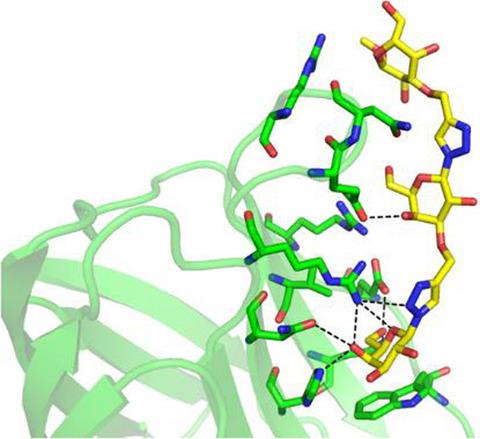当前位置:
X-MOL 学术
›
Chem. Bio. Drug Des.
›
论文详情
Our official English website, www.x-mol.net, welcomes your
feedback! (Note: you will need to create a separate account there.)
Linear triazole‐linked pseudo oligogalactosides as scaffolds for galectin inhibitor development
Chemical Biology & Drug Design ( IF 3.2 ) Pub Date : 2020-03-27 , DOI: 10.1111/cbdd.13683 Christophe Dussouy 1 , Chandan Kishor 2 , Annie Lambert 1 , Clément Lamoureux 1 , Helen Blanchard 2, 3 , Cyrille Grandjean 1
Chemical Biology & Drug Design ( IF 3.2 ) Pub Date : 2020-03-27 , DOI: 10.1111/cbdd.13683 Christophe Dussouy 1 , Chandan Kishor 2 , Annie Lambert 1 , Clément Lamoureux 1 , Helen Blanchard 2, 3 , Cyrille Grandjean 1
Affiliation

|
Galectins play key roles in numerous biological processes. Their mode of action depends on their localization which can be extracellular, cytoplasmic or nuclear, and is partly mediated through interactions with β‐galactose containing glycans. Galectins have emerged as novel therapeutic targets notably for the treatment of inflammatory disorders and cancers. This has stimulated the design of carbohydrate‐based inhibitors targeting the carbohydrate recognition domains (CRDs) of the galectins. Pursuing this approach, we reasoned that linear oligo‐galactosides obtained by straightforward iterative click‐chemistry could mimic poly‐lactosamine motifs expressed at eukaryote cell surfaces which the extracellular form of galectin‐3, a prominent member of the galectin family, specifically recognizes. Affinities towards galectin‐3 consistently increased with the length of the representative oligogalactosides but without reaching that of oligo‐lactosamines. Elucidation of the X‐ray crystal structures of the galectin‐3 CRD in complex with a synthesized di‐ and tri‐galactoside confirmed that the compounds bind within the carbohydrate‐binding site. The atomic structures revealed that binding interactions mainly occur with the galactose moiety at the non‐reducing end, primarily with subsites C and D of the CRD, differing from oligo‐lactosamine which bind more consistently across the whole groove formed by the five subsites (A‐E) of the galectin‐3 CRD.
中文翻译:

线性三唑连接的假低聚半乳糖苷作为半乳糖凝集素抑制剂开发的支架
半乳凝素在许多生物学过程中起着关键作用。它们的作用方式取决于其定位,这些定位可以是细胞外的,细胞质的或核的,并且部分地通过与含β-半乳糖的聚糖的相互作用来介导。半乳凝素已经作为新型治疗靶标出现,特别是用于治疗炎症性疾病和癌症。这刺激了针对半乳糖凝集素的碳水化合物识别域(CRD)的基于碳水化合物的抑制剂的设计。遵循这种方法,我们认为通过简单的迭代点击化学方法获得的线性低聚半乳糖苷可以模拟在真核细胞表面表达的聚乳糖胺基序,这是半乳糖凝集素家族3的一个重要成员,细胞外形式的半乳糖凝集素3可以特异性识别。对半乳凝素3的亲和力随着代表性的寡半乳糖苷的长度而持续增加,但未达到寡乳糖胺的长度。阐明了半乳糖凝集素3 CRD的X射线晶体结构与合成的二和三半乳糖苷的复合物,证实了这些化合物在碳水化合物结合位点内结合。原子结构表明,结合相互作用主要发生在非还原端的半乳糖部分,主要是CRD的C和D位,与低聚乳糖胺不同,后者在五个亚位形成的整个凹槽中更一致地结合(A ‐E)的半乳凝素3 CRD。阐明了半乳糖凝集素3 CRD的X射线晶体结构与合成的二和三半乳糖苷的复合物,证实了这些化合物在碳水化合物结合位点内结合。原子结构表明,结合相互作用主要发生在非还原端的半乳糖部分,主要是CRD的C和D位,与低聚乳糖胺不同,后者在五个亚位形成的整个凹槽中更一致地结合(A ‐E)的半乳凝素3 CRD。阐明了半乳糖凝集素3 CRD的X射线晶体结构与合成的二和三半乳糖苷的复合物,证实了这些化合物在碳水化合物结合位点内结合。原子结构表明,结合相互作用主要发生在非还原端的半乳糖部分,主要是CRD的C和D位,与低聚乳糖胺不同,后者在五个亚位形成的整个凹槽上更一致地结合galectin-3 CRD的‐E)。
更新日期:2020-04-22
中文翻译:

线性三唑连接的假低聚半乳糖苷作为半乳糖凝集素抑制剂开发的支架
半乳凝素在许多生物学过程中起着关键作用。它们的作用方式取决于其定位,这些定位可以是细胞外的,细胞质的或核的,并且部分地通过与含β-半乳糖的聚糖的相互作用来介导。半乳凝素已经作为新型治疗靶标出现,特别是用于治疗炎症性疾病和癌症。这刺激了针对半乳糖凝集素的碳水化合物识别域(CRD)的基于碳水化合物的抑制剂的设计。遵循这种方法,我们认为通过简单的迭代点击化学方法获得的线性低聚半乳糖苷可以模拟在真核细胞表面表达的聚乳糖胺基序,这是半乳糖凝集素家族3的一个重要成员,细胞外形式的半乳糖凝集素3可以特异性识别。对半乳凝素3的亲和力随着代表性的寡半乳糖苷的长度而持续增加,但未达到寡乳糖胺的长度。阐明了半乳糖凝集素3 CRD的X射线晶体结构与合成的二和三半乳糖苷的复合物,证实了这些化合物在碳水化合物结合位点内结合。原子结构表明,结合相互作用主要发生在非还原端的半乳糖部分,主要是CRD的C和D位,与低聚乳糖胺不同,后者在五个亚位形成的整个凹槽中更一致地结合(A ‐E)的半乳凝素3 CRD。阐明了半乳糖凝集素3 CRD的X射线晶体结构与合成的二和三半乳糖苷的复合物,证实了这些化合物在碳水化合物结合位点内结合。原子结构表明,结合相互作用主要发生在非还原端的半乳糖部分,主要是CRD的C和D位,与低聚乳糖胺不同,后者在五个亚位形成的整个凹槽中更一致地结合(A ‐E)的半乳凝素3 CRD。阐明了半乳糖凝集素3 CRD的X射线晶体结构与合成的二和三半乳糖苷的复合物,证实了这些化合物在碳水化合物结合位点内结合。原子结构表明,结合相互作用主要发生在非还原端的半乳糖部分,主要是CRD的C和D位,与低聚乳糖胺不同,后者在五个亚位形成的整个凹槽上更一致地结合galectin-3 CRD的‐E)。











































 京公网安备 11010802027423号
京公网安备 11010802027423号